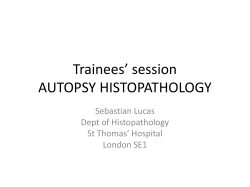
Glenn G. Druckenbrod, M.D. Medical Director Department of Emergency Medicine Inova Fairfax Hospital
Glenn G. Druckenbrod, M.D. Medical Director Department of Emergency Medicine Inova Fairfax Hospital Best Practices, Inc. Ponte Vedra 6/21/2012 40 year old male c/c – HA, abdominal pain, feels weak PMH – HBP Vitals – 104/68, P – 114, RR – 22, T – 98.9 PE – Looks well, AAO X 3, Mild suprapubic tenderness Labs – WBC 9.9, BUN/Cr – 24/1.9, U/A – 5 – 10 WBCs, lactate 2.4 Treatment –One liter IV NS, IV ABX Repeat vitals – 101/64, P – 118, RR - 24, T – 98.7 Admitted to the floor Ponte Vedra 6/21/2012 Four hours after admission “rapid response” called for BP 60/p Eventual diagnosis: prostatitis Blood cultures positive for E. Coli Ponte Vedra 6/21/2012 Sepsis clues – persistent tachycardia BP (relatively) low for a hypertensive patient Increasing RR Elevated creatinine Ponte Vedra 6/21/2012 Provider discounted sepsis risk because – The patient looked “well” Tachycardia noted and was the reason for admission Elevated creatinine thought due to dehydration RR on chart never noted Ponte Vedra 6/21/2012 60 year old female Throat cancer, recent chemo with c/c of weakness, difficulty eating, sore throat and no fever by history BP - 97/52, P – 126, RR – 25 (non labored), T – 99oF PE – looks well, mucous membranes dry Labs – WBC 0.8, BUN/Cr 44/1.9, Lactate 2.8, CXR RLL consolidation Subsequent vitals – 104/56, P - 129, RR - 29 and 118/57, P – 129, RR – 28, T – 98.7 Treatment – NS X 1 L, Zosyn and Vancomycin Admit intermediate care (i.e., ICU step down) Ponte Vedra 6/21/2012 Dropped blood pressure within 4 hours Transferred to ICU Eventually succumbed Ponte Vedra 6/21/2012 Sepsis clues – BP Pulse RR Renal insufficiency Immune status Ponte Vedra 6/21/2012 Provider follow-up – Patient looked good despite vitals Recognized immune state Pulse felt secondary to dehydration and underlying debilitated status RR noted but not processed. No evidence of distress Creatinine elevation caused by dehydration Ponte Vedra 6/21/2012 60s female BIBA difficult to arouse. PMH remarkable for recent kidney stone, on narcotic pain medication. Denies other symptoms. Vitals – 77/45, P – 94, RR – 22, T – 97.1oF PE – awake and alert, oriented X 3. Abd: min L tend, + L flank tenderness Labs – WBC 10.7, BUN/Cr 70/5.5, Lactate 3.4, D-dimer 4067, UA 10-15 WBC Subsequent vitals – 82/50, P – 96 and 95/55, P – 109 Initially admitted to step down unit, ABX 4 hours after arrival. Ponte Vedra 6/21/2012 While boarding in ED patient suffered cardiac arrest: successfully resuscitated Blood and urine cultures positive. Infected, obstructed kidney stone Ponte Vedra 6/21/2012 Sepsis clues – Renal insufficiency Hypotension Elevated lactate Elevated D-dimer Tachypnea Ponte Vedra 6/21/2012 Provider follow-up BP felt secondary to narcotics Renal status from stone Lactate noted, uncertain of significance D-dimer level not understood Ponte Vedra 6/21/2012 Sepsis Early goal directed therapy (EGDT) in treatment of severe sepsis and septic shock. * *Rivers, et al Nov 8 th 2001 in NEJM Ponte Vedra 6/21/2012 Mortality: •Standard Therapy – 46.5% •EGDT – 30.5% Ponte Vedra 6/21/2012 Mortality Benefit*: •Thromobolytics – 12% •PCI – 7% *Danami-2 Study 2002 Ponte Vedra 6/21/2012 Adjusting cardiac preload, afterload and contractility to balance oxygen delivery with oxygen demand. Ponte Vedra 6/21/2012 River’s Study: •263 patients •130 EGDT- 30.5% mortality •133 Standard Therapy – 46.5% mortality Ponte Vedra 6/21/2012 Keys to EGDT Central Venous Catheter capable of central venous O2 sat. 6 Hours of intense treatment in the ED. 500 CC boluses q30 minutes for CVP 8-12 mm/hg. MAP <65 mm/hg vasopressors utilized. MAP >90 mm/hg vasodilators utilized. Central Venous O2 sat of <70% RBC’s transfused to HCT of 30. Optimized patients had Dobutamine begun if central venous O2 sat remain <70. • Mechanical ventilation and sedation for non optimized patients to reduce O2 demand. • • • • • • • Ponte Vedra 6/21/2012 Sepsis – Presence of infection in conjunction with the systemic inflammatory response syndrome (SIRS). Ponte Vedra 6/21/2012 SIRS Two or more of the following: • • • • • • Source of infection Lactate >4 Temperature <36C or >38C HR >90 BPM RR >20 or PACO2 <32 WBC >4,000 or >12,000 or bands >10% Ponte Vedra 6/21/2012 Severe Sepsis – Sepsis with evidence of organ dysfunction 1. 2. 3. 4. 5. 6. Altered mental status Creatinine increase >0.5 mg/dl from baseline Coagulation abnormalities Thrombocytopenia Oliguria Arterial hypoxemia Ponte Vedra 6/21/2012 Septic Shock Severe sepsis and hypotension unresponsive to 20 cc/kg bolus Ponte Vedra 6/21/2012 Lactate – Easily available marker of severity of illness. Ponte Vedra 6/21/2012 Lactate Mortality 0-2.5 4.9% 2.6-4 9% >4 36% Ponte Vedra 6/21/2012 Lack of fever End organ dysfunction, typically increased creatinine, attributed to dehydration Anchoring on another diagnosis Ignoring tachycardia or increased RR Patients “look good” Ponte Vedra 6/21/2012 Septic patients look good. Then they die. Ponte Vedra 6/21/2012 Institutional Response to Sepsis Surviving Sepsis Campaign – • Build Awareness and increase use of proper treatment saw mortality decrease when management bundles were utilized. •Database use has markedly decreased over time. Ponte Vedra 6/21/2012 CMS added sepsis to ruling regarding hospital infection. Goal is to shift cost to providers. (2010) Ponte Vedra 6/21/2012 Hours of in hospital Sepsis meetings…….. Ponte Vedra 6/21/2012
© Copyright 2025














